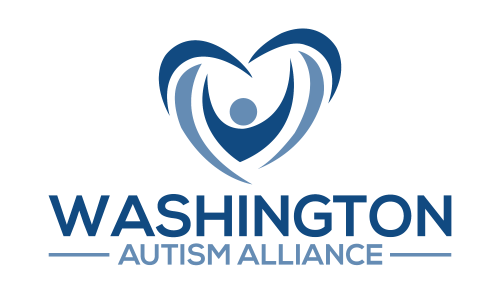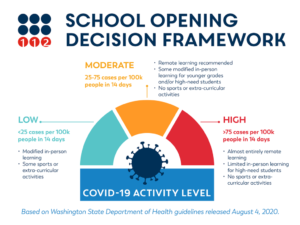The Department of health (DOH) acknowledges that "schools are fundamental to child and adolescent development and well-being. They provide our children and adolescents with academic instruction, social and emotional skills, safety, reliable nutrition, physical/speech and mental health therapy, and opportunities for physical activity. This guidance provides feasible actions schools can take to reduce risks to student and staff from COVID-19 and allow schools to resume in-person instruction."
We encourage you to familiarize yourself with the DOH guidance prior to advocating for in-person services.
The following decision tree from DOH is a high-level summary of the changes:
• Under COVID-19 Activity Level, DOH clarified and made consistent across all three activity levels that health and education leaders should look at the trends in COVID-19 cases and hospitalizations and test positivity should ideally be lower than 5%.
• Under Education Modality, DOH clarified that in communities with Moderate COVID-19 Activity, they recommend careful phasing in of in-person learning, starting with elementary. Then, over time, if schools can demonstrate the ability to limit transmission in the school environment, schools should add in-person learning for middle and high school.
• Under Extracurricular, DOH created flexibility for schools and districts to cautiously phase in extracurricular activities as they phase in in-person learning to create more parity between school-related and community related activities based on disease activity level. DOH continues to prioritize educational opportunities over extracurricular or other activities in the surrounding community.
This tool provides metrics to guide local decisions, based on the COVID-19 disease activity in the community surrounding the school.
Key Principles for Reducing Potential Exposures
The main ways of reducing exposure to the coronavirus and other respiratory pathogens involve:
- Keeping ill persons out of school. Educate students, families and staff to stay home when sick, and use screening methods.
- Using cohorts. Conduct all activities in small groups that remain together over time with minimal mixing of groups.
- Physical distancing. Minimize close contact (less than six feet) with other people.
- Hand hygiene. Frequently wash with soap and water, or use alcohol-based hand gel.
- Protective equipment. Use face coverings or shields and other barriers between people.For employees, follow all Labor and Industries (L&I) and Employer Health & SafetyRequirements for School Scenarios guidance.
- Environmental cleaning and disinfection. Prioritize the cleaning of high-touch surfaces.
- Improve indoor ventilation. Open windows when possible.
- Isolation. Isolate sick people and exclude exposed people.
- Low risk spaces. Outdoor spaces are safer than indoor spaces. Consider movingactivities outdoors when possible.


